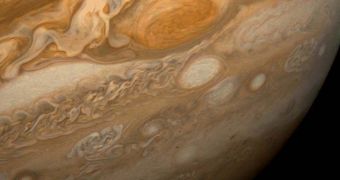Recent studies conducted at Jupiter indicate that the massive gas giant's core has been dissolving. They also indicate that the core may not be made up of rock or other solid chemicals, and that it may not contain layers at all. These data could help explain a lot of aspects experts found on CoRoT-20b.
The latter is an extrasolar planet located around the star CoRoT-20. It was announced just last month, by a collaboration of astronomers operating the French space agency CNES' (Centre National d'Etudes Spatiales) COnvection ROtation and planetary Transits (CoRoT) satellite.
One of the things that immediately surprised astronomers when they looked at the alien world was that it displayed an unusual density. In order to account for such high density values, experts say that more than half of the planet should be made up of solid materials.
However, this is known to be highly unlikely. Gas giants, as their name aptly describes, are made out of hydrogen gas for the most part, and feature only small solid cores. On Jupiter, the core makes up for around 3 to 15 percent of the planetary mass.
In computer models, the gas giant is always represented in a layered configuration, where a gassy outer envelope made up of neatly-stacked layers surrounds an equally-layered inner core, made up of heavier chemical elements, Daily Galaxy reports.
“People have been working on the assumption that these planets are layered because it's easier to work on this assumption,” researcher Hugh Wilson explains. But no one ever bothered to complete the actual calculations associated with a scenario in which this is simply not true.
Wilson, a University of California in Berkeley (UCB) planetary scientist, was a coauthor of a new paper detailing the findings, which appears in the latest issue of the esteemed scientific journal Physical Review Letters.
It could be that the inside of Jupiter-class giants is made up of a mixture of elements that have no clear boundaries between them. “It's much easier to explain the composition of [CoRoT-20b] under a model where you have a mixed interior,” Wilson explains.
Experts have about 4 more years to wait until such questions are resolved. The NASA Juno spacecraft is already on its way to Jupiter, and will reach the gas giant by 2016. The equipment it carries should be enough to allow in-depth studies of the planet's interior.

 14 DAY TRIAL //
14 DAY TRIAL //